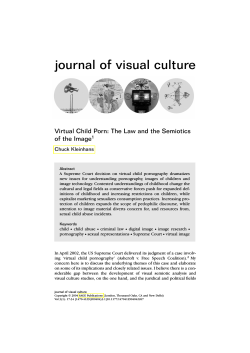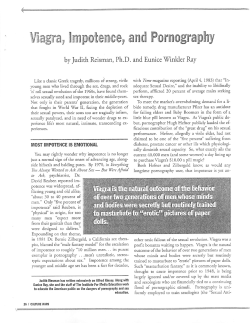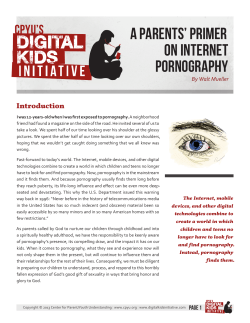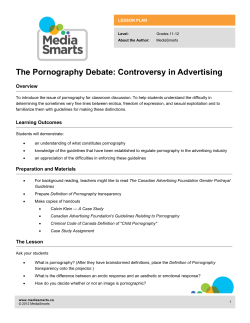
Document 75809
SENATE COMMITTEE ON COMMERCE, SCIENCE, AND TRANSPORTATION
Subcommittee on Science, Technology, and Space
Witness List*
Hearing on the Brain Science Behind Pornography Addiction
/
and the Effects of Addiction on Families and Communities
Thursday. November 18, 2004. at 2:00 p.m.,
in Room 253 of the Russell Senate Office Building
Panel I
Dr. Judith Reisman, Scientific Advisor, California Protective Parents Association, P.O. Box
15284, Sacramento, CA 95851
Dr. Jeffrey Satinover, P.O. Box 1183, Weston, CT 06883
Dr. MaryAnne Layden, Co-Director, Sexual Trauma and Psychopathology Program, Center for
Cognitive Therapy, University of Pennsylvania, 3535 Market Street, 2~Floor,
Philadelphia, PA 19104
Dr. James B. Weaver, ifi, Professor, Virginia Polytechnic Institute and State University,
Department of Communication, Shanks Hall (0311), Blacksburg, VA 24061
*Not necessarily in order of appearance.
Statement of Judith A. Reisman, Ph.D.,
President, Institute for Media Education
Testimony before the United States Senate,
Subcommittee on Science, Technology, and Space
of the
Committee on Commerce, Science, and Transportation
on
"The Brain Science Behind Pornography Addiction and
the Effects of Addiction on Families and Communities"
November 18, 2004
Good afternoon. Thank you for the opportunity to speak with you today. I am Judith
Reisman, Ph.D., President of The Institute for Media Education, Scientific Advisor to the
California Protective Parents Association and the Subcommittee on Junk Science for The
American Legislative Exchange Council’s April 2004 report. 1
I specialize in the communication effects of images on the brain, mind and memory; fraud
in the human sexuality field; and the addictive properties of sexually explicit images,
commonly called pornography. 2
My working, scientific definition of pornography is measurable: “intimate private-space
behavior in public space forums, provoking psychopharmacological responses in viewers
that puts the model and those s/he represents, at risk.” See Appendix A.
Thanks to the latest advances in neuroscience, we now know that emotionally arousing
images imprint and alter the brain, triggering an instant, involuntary, but lasting,
biochemical memory trail.
This applies to so-called "soft-core" and "hard-core" pornography, which may, arguably,
subvert the First Amendment by overriding the cognitive speech process.
Once our neurochemical pathways are established they are difficult or impossible to delete.
Erotic images also commonly trigger the viewer’s "fight or flight” sex hormones producing
intense arousal states that appear to fuse the conscious state of libidinous arousal with
unconscious emotions of fear, shame, anger and hostility. 3
2
These media erotic fantasies become deeply imbedded, commonly coarsening, confusing,
motivating and addicting many of those exposed. (See "the Violence Pyramid" at
http://www.vbii.org/violence.html).
Pornography triggers a myriad of endogenous, internal, natural drugs that mimic the "high"
from a street drug. Addiction to pornography is addiction to what I dub erototoxins – mind
altering drugs produced by the viewer's own brain.
How does this 'brain sabotage' occur? Brain scientists tell us that "in 3/10 of a second a
visual image passes from the eye through the brain, and whether or not one wants to, the
brain is structurally changed and memories are created - we literally 'grow new brain' with
each visual experience." 4
Children and others who cannot read can instantly decode and experience images, hence
images are not speech.5 In fact, erotic (any highly arousing) images commonly subvert left
hemisphere cognition.6
Since the 50s, as pornography became mainstreamed and pushed the envelope of normal
sexual conduct, law enforcement reported that sex crimes mimicking comparable acts were
being inflicted on women and children. (See OJJDP study) 7
I have spent decades addressing the effects of pornographic "humor" and photos on
children, fathers, husbands and wives and communities, much of which is found in my
book, ''Soft" Porn Plays Hardball, 1990,8 in my U.S. Department of Justice, Office of
Juvenile Justice and Delinquency Prevention (OJJDP) report, Images of Children, Crime
and Violence in Playboy, Penthouse and Hustler,9 and in my white paper on "The
Psychopharmacology of Pictorial Pornography: Restructuring Brain, Mind & Memory &
Subverting Freedom of Speech" (http://www.dJjudithreisman.com/brain.pdf).
A basic science research team employing a cautiously protective methodology should
study erototoxins and the brain/body. As with tobacco, these data could be helpful in
public education and in legal change.
Testimony from victims and police commonly finds pornography to be an on-site-sexabuse manual. 10
An offensive strategy should be planned mandating law enforcement collection of all
pornography data, as with guns, drugs, etc, at crime sites.
Judges, police, legislators and lawyers should be trained in the hard data of sexology fraud
and erototoxins as changing the human brain, mind, memory at unconscious levels and
therefore absent informed consent.
Congress should consider ceasing the funding of educational institutions that train their
students via the flawed methodology of Kinseyan “academic” pornography.11
3
Congress should consider determining which sexology institutes have received financial
support from pornographers. Based on this obvious conflict of interest, their authority to
confer professional credentials or to hold themselves out as expert witnesses might be
rescinded.
These initial steps can help reestablish the blessings of liberty and tranquility for our
children, our communities and our country.
Thank you very much.
ENDNOTES
1
See vitae for other details (http://www.drjudithreisman.org/vitae.htm).
I also document the ways pornography commonly involve "estrus" displays, falsely
presenting human females as non-human animals in "heaf' and triggering both anger and
libido in male, even some female, viewers. The full definition relies upon the four
scientific disciplines of Proxemics, Ethology, Neuropsychology and
Psychopharmacology, seen ve in Appendix A.
3
Richard Restak, (1988). The Mind, Bantam Books, New York. "Inhibition rather than
excitation is the hallmark of the healthy brain. If all of the neurons in the brain were
excitatory we would be unable to do something as simple as reaching out for a glass of
water, " p. 283.
4
Restak in Bill Moyers,' "Mind & Body: The Brain," PBSTV, February 1993.
5
On the undeveloped adolescent brain and its lack of cognitive maturity see Science,
''Neuroscience: Crime, Culpability, and the Adolescent Brain," Vol 305, Issue 5684, 596599, July 2004. Shall teenagers under 18 get the death sentence--based in part on brain
studies, pp. 596-599.
6
See Gary Lynch in Restak (1984). "The Brain, Learning & Memory" The Annenberg/
CPB Collection, in his discussion of the way arousing images alter the structure of the
human brain, WNET/NY, full documentation in 8. Exhibits 1 and 2.
7
. Exhibit 1.
8
Exhibit 2.
9
Exhibit 3.
10
John Rabun, now COO for the National Center For Missing & Exploited Children. See
Senate Hearings on "Effect of Pornography on Women and Children," 1984. In that Senate
hearing, Rabun testified that when arrested, "all, that is 100%" of rapists, pedophiles, etc.,
in their study possessed adult pornography, "such as Playboy, on up.” Also see Dr. C.
Everet Koop on pornography as a "crushing" health problem, in American Medical News,
(October 10, 1986).
11
Exhibit 3. See JA Reisman, Kinsey, Crimes & Consequences, 2003, pp. 160-180, esp.
170-'80: for the use of the SAR, Sexual Attitude Restructuring, as days, weeks or months
of viewing pornography to be "accredited" as a certified sex educator, or to earn a Masters,
PhD., etc., in Human Sexuality, AIDS Prevention and the like.
2
Jeffrey Satinover, M.S., M.D.
All communications to
38 Steephill Road, Weston, Connecticut, USA 06883
TEL USA+1 203.221.0031
FAX USA+1 203.222.1656
~
PrincetonUniversi’ty
~
flu e
‘0 01 I
L;’t~,r:iiar.,,iei~hv,, ae.1 I~
iI,t,~,Con.k’mL’
1
Department of Politics
028 corwin Hall, Princeton, New Jersey 08544
TEL USA-i-i 609.258.8326 FAX 609.258.1110
TEL USA+1 609.258.6423
voicemail 33326
Lecturer in Constitutional Law & Civil Liberties (on Leave)
Physique pluridisciplinaire
CNRS Li. M. R. 6622
Parc Valrose 06108 Nice cedex 2
Tél Accuell 04 9207 6792 FAX 0492076754
Candidat doctoral dans Ia physique théorique
Wednesday, November 17, 2004
Dear Senator Brownback, Honorable Members of the Committee:
It has always seemed self-evident that pornography is nothing more than a form of “expression.” Its putative merits, lack thereof, or evils always therefore have been debated in terms
appropriate to “expression,” and our laws reflect as much. We argue over the “morality” of
pornographic literature; its nature as “high” or “low” art; whether it has any “redeeming
value.” References to “works” of pornographic “literature” and “acts” of pornographic
“dance” are enshrined at the highest levels of American constitutional jurisprudence—the
words in quotation marks making it clear that the understanding of pornography as expression is foundational and unquestioned.
Senator, distinguished members, I respectfully submit to this committee that modern science
allows us to see that this is an illusion: Pornography is mere “expression” only in the trivial
sense that a fall from the Empire State building is a mere stumble—since it’s hitting the
ground that’s fatal. Or, that cigarettes don’t cause cancer, it’s the burning smoke that’s the
problem.
Here is what I mean: Like cigarettes, that particular form of expression we call pornography,
unlike all other forms of expression, is a delivery ystem that has a distinct andpowe~ftleffect upon the
human brain and nervous 4ystem. Exactly like cigarettes, and unlike any other form of expression,
this effect is to cause a powerful addiction. Like any other addiction, the addictionis both to
the delivery system itself—the pornography—and to the chemicals that the delivery system
delivers.
It may seem surprising that, at this juncture, I should speak of “chemicals”, when one might
be thinking instead of “sex.” But, in fact, modem science allows us to understand that the
underlying nature of an addiction to pornography is chemically nearly identical to a heroin
addiction: Only the delivery system is different, and the sequence of steps. That is why heroin addicts in particular give up sex and routinely compare their “rushes” to “orgasms”.
The chemistry involved is as follows: Upon viewing or reading the “expression”, the pornography addict experiences an irresistible impulse to self-stimulation. Not so upon reading
Melville, or Batman or The U7ashin,gton Post. For the addict, this impulse has become more
intense from pornography than from people he loves or who love him, and also requires
ever more extreme forms of pornographic expression to achieve the same level of pleasure.
Upon achieving climax, the brain releases opioids—chemicals that are the naturally occurring
analogs to synthetic opiates such as morphine or heroin. It is to ever higher levels of these
,sATINov@pRaNcEroN . EDU
www.PRINcETON . Eou/—JSATIN0v
opioids that the pornography addict has become addicted in tandem with the delivery system
that ensures their release. Indeed, he—and today, with the internet, in ever increasing numbers, she—has become part of that delivery system—along with the pornographic “expression” itself. The pornography addict soon forgets about everything and everyone else in favor of an every more elusive sexual jolt. He will eventually be able to find it only among
other “junkies” like himself, and he will place at risk his career, his friends, his family. He will
indulge his habit anywhere and everywhere, at any time. No one, no matter how highly
placed, is immune. And like all other addicts, the pornography addict will lie to conr it up,
heedless of risk or cost to himself or to others.
In the year 2000, ABC-NEWS.com cooperated with the journal CyberPsychology & Behavior in a survey of 17,251 individuals. They found that 6% of those surveyed met formal critetia for a frill-fledged internet pornography addiction. Another survey found that 41 D/~of corporations had disciplined or terminated employees within the previous year because of severe problems with internet pornography. The next largest problem was chat rooms at l2%-and many of these involved sexual chat. All other internet problems were much less consequential, and at lower percentages, even gambling. These studies are but the mere tip of an
ever growing iceberg.
Senators, honorable members, it was once possible with sincerity and rigor to maintain that
pornographic expression had to be considered on the same abstract and elevated plane as
any other form of expression, and that to do otherwise would gravely harm the foundation
of our freedoms. It is no longer possible to do so without turning a blind eye to the plain
evidence of neurophysiology and epidemiology. Like all forms of expression (and a great
many other things) it is even more broadly speaking a kind of “stimulus”. And it is as a
stimulus of a most distinct sort that its operational effects can be best understood. These
effects are “tuned” as it were, to the deepest and oldest biological impulses of human beings
as physical organisms driven to survive via the reproductive act. Hence, the most intense
pleasurable reinforcement is associated with sexual stimulation. Certain kinds of synthetic
stimulation, properly designed and rapidly delivered can act just as effectively as physical
stimuli upon the chemical-releasing centers in the brain (and elsewhere in the body); as effectively and immediately as though one had inserted an electrical probe into the brain, or a
needle into the arm.
With advent of the computer, the delivery system for this addictive stimulus has become
nearly resistance-free. It is as though we have devised a form of herpin 100 times more powerful than before, usable in the privacy of one’s own home and injected directly to the brain
through the eyes. It’s now available in unlimited supply via a self-replicating distribution
network, glorified as art and protected by the Constitution.
I will be glad to provide you and your colleagues with additional information and documentation.
Sincerely,
Jeffrey Satinover, M.S., M.D.
JBS:sc
JsATffiov@prnNceTou.EDu
-2
www.PRINcET0F4 . Eou/~isATINov
Additional Comments and Supporting Materials
From Science, 2001: [S]cientists have traditionally confined their use of the term to
substances--namely alcohol and other drugs--that clearly foster physical dependence in the user.
That’s changing, however. New knowledge about the brain’s
reward system,
much gained by super refined brain scan technology, suggests
that as far as the brain is concerned, a reward’s a reward, regardless of whether it
comes from a chemical or an experience. And where there’s a reward, there’s the
risk of the vulnerable brain getting trapped in a compulsion. ‘Over the past 6
months, more and more people have been thinking that, contrary to earlier
views, there is commonality between substance addictions and other compul‘~ions,” says Alan Leshner, head of the National Institute on Drug Abuse (NIDA)
and incoming executive officer of the American Association for the Advancement of Science, publisher of Science.
[says] Howard Shaffer, who heads the
Division on Addictions at Harvard. .a lot of addiction is the result of experience repetitive, high-emotion, high-frequency experience. But its become clear
...
“. .
...
that neuroadaptation—that is, changes in neural circuitry that help perpetuate
the behavior—occurs even in the absence of drug-taking.” “Addiction occurs
when a habit hijacks brain circuits that evolved to reward survival-enhancing
behavior such as eating and sex,” according to this article in Science 294, 980-982.
“It stands to reason if you can derange these circuits with pharmacology, you can
do it with natural rewards too,” observes Stanford University psychologist Brian
Knutson. Thus, drugs are no longer at the heart of the matter. “What is coming
up fast as being the central core issue is continued engagement in selfdestructive behavior despite adverse consequences,” says Steven Grant of NIDA.
...
As reported in the British medical journal Lancet (Vol 364 July 31, 2004) Jenizbek
Nazarilez, M.D., has had remarkable success nearly 90% in reversing severe
opiate, cocaine and alcohol addictions in Central Asia by using an extraordinarily aggressive form of coma-inducing treatment based on the assumption that
.addiction has inhibited the production of endorphins.” UN Secretary-General
Kofi Annan, California Governor, Arnold Schwarzenegger, and the Dalai Lama
have all pledged their support. Over 17,000 individuals have undergone treatment so far. The evidence is not only of critical importance with respect to drug
treatment proper, but provides indirect evidence that the common neurochemical denominator of all addictions is opioid, placing the sexual addictions
squarely at the center of interest and concern.
—
—
“..
the impact ofthe opioid system for psychiatric disorders especially with
regard to affective disorders and addiction. work in this area continued successfully”. (See Falk Kiefer, Mirko Hornirich, Holger Jahn and Klaus Wiedemann, Is
withdrawal-induced anxiety in alcoholism based on b-endorphin deficiency?
Psycl-tophannacology (2002) 162:433—437). The intensity of alcohol withdrawal is
...
. .
JSAT,NOV@ pluNcEroN . ED~J
-3-
WWW . PRiNCEtON.EDU/’)SATINOV
related to extent of endorphin depletion. To the extent that sex- and pornography
addicts become endorphin-depleted; and that addictions tend to be multiple (alcohol, drug, sex and pornographic addictions are frequently found in combination; sex and alcohol binges come in tandem), the intensity of alcohol withdrawal
and associated cravings may be expected to be increased by the pornography
addiction and vice versa. Multiple addictions are neurophysiologically entangled
and mutually reinforcing as they share a common chemical pathway.
The ready availability of internet pornography has made the progression from
choice to habit to cQmpulsion to overt addiction with destructive real-world consequences stark and inarguable. Furthermore, earlier delivery systems for porhography involved sufficient “friction” effort; time between initiation of action
and imprinting of the imagery in the nervous system; capacity to swiftly enough
tune the imagery to the specific sensitivities of the recipient that the barriers
were on a statistical basis too high for most women. On a statistical basis, addic—
—
tion to pornography was therefore overwhelmingly found among men and boys.
With the advent of internet pornography, however, this friction has been drasti-
cally lowered. As a result, there has been an almost immediate and dramatic increase in the number ofwomen who have been tracked as following the same
sequence from choice to habit to overt addiction, including women with no prior
involvement in sado-masochism who became addicted to it through internet
pornography that eventually led to overt extra-marital engagements. “Some respondents described a rapid progression of a previously existing compulsive
sexual behavior problem whereas others had no history of sexual addiction but
became rapidly involved in an escalating pattern of compulsive cybersex
use.. .Adverse consequences included.. .harm done to their marriage...exposure
of children to online pornography or masturbation, career loss,.. .legal consequences.” (Jennifer Schneider, A Qualitative Study of Cybersex Participants:
Gender Differences, Recovery Issues and Implications for Therapists. Sexual Addiction and Cornpulsivity 7:249-278 (2000)
So well understood is the relation of the endorphin system to pleasure, that a device to directly stimulate release is being tested by the Russians and by University of Texas, Southwestern Medical School: Devices for Noninvasive Transcranial Electrostimulation of the Brain Endorphinergic System: Application for Improvement of Human Psycho-Physiological Status, Valery P. Lebedev, A.V. Malygin, A.V. Kovalevski, S.V. Rychkova, V.N. Sisoev, S.P. Kropotov, E.M. Krupitski, L.l. Gerasimova, D.V. Glukhov, and G.P. Kozlowski. Artificial Organs,
26(3):248—251 (2002) Blackwell Publishing, Inc.
The brain effect of pornographic imagery versus non-pornographic imagery is
instant and immediately identifiable and differentiable between men and
women. “SEEN IT!” EFFECTS OF STIMULUS SEQUENCE ON EMOTIONAL
-
JsA-r,wov©pRlNcEroN . EDU
4-
www.pRlNcEroN.EDu/ JSATINOV
PICTURE PERCEPTION, Tobias Flaisch, Markus Junghoefer, University~ofICon-
stanz; Margaret M. Bradley, University of Florida; Harald Schupp, University of
Konstanz; and Peter J. Lang, University ofFlorida. Poster Presentation on fMRI
imaging of differential brain effects ofrapid pornographic images in males and
females. Society for Psychophysiological Research 44th Annual Meeting, Octo-
ber 20-24, 2004, La Fonda Hotel, Santa Fe, New Mexico, Poster Session I, Main
Floor Sweeney Convention Center, Thursday, October 21, 8:00 p.m.-10:0O p.m.;
also Human Brain Mapping 16:1—13(2002) using Quantitative EEG and Nature
Neuroscience 7:4,411-416 (March, 2004) using fMRI.
fMRI Imaging shows that in addictive states, even craving is associated with disIinct brain states in the addict (Am J Psychiatry 158:7, July 2001; Am J Psychiatry
2001; 158:86—95), in that part ofthe brain called the am~gdala.Recall that the
craving state is associated with endorphin depletion, and endorphins are the
chemical pre-eminently associated with orgasm. Other studies show similar
changes associated with both alcohol and other addictive cravings as well, unsurprisingly.( Effect of experimenter-delivered and self-administered cocaine on
extracellular b-endorphin levels in the nucleus accumbens, I. Roth-Den, A. Zangen, M. Aleli, R. G. Goelman, G. Pelled, R. Nakash, I. Gispart-Herman, T. Green,
Y. Shaham and G. Yadid, Journal ofNeurochemistry, 2003, 84, 930—938) A review
of the new approaches to addiction shows that regardless of the cause, changes in
brain structure are inevitable (AR Lingford-Hughes, SJC Davies, S Mclver, TM
Williams, MRC Daglish and DJ Nutt, Psychopharmacology Unit, School of Medical Sciences, University of Bristol, Bristol, UK British Medical Bulletin 2003; 65:
209—222):
Alcohol and psycho-active substance misuse has far-reaching social, psychological and
physical consequences. Advances in neuroimaging technology have allowed neurobiological theories of addictionto become better characterized. We describe the neurobiology of dependence, withdrawal, abstinence and craving states in alcohol, stimulant and
opiate misuse. Structural neuroimaging techniques such as CF and Millwith new analytical approaches such as voxel based morphometry have shown wide-spread changes
in stimulant and opiateabuse and atrophy, particularly in the frontal lobes, in alcoholism. Functional neuroimaging techniques such as PET, SPECF and HART reveal altered
regional cerebral activity by all drugs of abuse. The neurochemistry of addiction, particularly involving dopamine, serotonin, opiate and CABAL, has been studied with PET and
SPECK and similarities between all drugs of abuse have been found such as reduced
dopaminergic markers. The evidence derived from these advances in neuroimaging is
lilcely to herald the emergence of new biological treatments in this importantfield.
A review of neuroimaging studies of how the brain changes as a consequence of
addictive changes may be found at Nat Neurosci. 2004 Mar;7(3):211-4. Epub 2004
Feb24.
Injection of cocaine alters endorphin levels (which leads to the feedback that
eventually causes its depletion as in all addiction). This can be seen immediately
on fMRI (Effect of experimenter-delivered and self-administered cocaine on extracellular b-endorphin levels in the nucleus accumbens, I. Roth-Den, A. Zangen,
)SAT,Nov@PRINcET0N . EDU
5
WWW.PRINcErON.EDU/ “~SATINOV
M. Aleli, R. C. Goelman, G. Pelled, R. Nakash, I. Gispan-Herman, T. Green, Y.
Shaham and G. Yadid, Journal of Neurochemistry, 2003, 84, 930-938).
Not only does viewing pornography produce specific responses in certain brain
areas as demonstrated using fMRI, the attempt to suppress that response is associated with activation of different areas of the brain (prefrontal and sublimbic regions), which suppression only occurs in non-addicted individuals, a marker for
future studies. The Journal of Neuroscience, 2001, Vol. 21
References in Testimony Letter:
Lost in Cyberspace~The Web @ Work, DAVID N. GREENFIELD, Ph.D., and
‘RICHARD A. DAVIS, M.A., CyberPsychology & Behavior, Volume 5, Number 4,
2002
GREENFIELD, D.N., Psychological Characteristics of Compulsive Internet Use:
A Preliminary Analysis. CyberPsychology & Behavior 2:,403-412 (2000)
/
JSATINOV@PR1NCETON.EDU
6
WWW.PRLNCETON . EDUfrJSATINOV
TESTIMONY FOR
U. S. SENATE
COMMITTEE ON COMMERCE, SCIENCE AND TRANSPORTATION
November 18, 2004
Mary Anne Layden, Ph. D.
-
Co-Director
Sexual Trauma and Psychopathology Program
And
Director ofEducation
Center for Cognitive Therapy
Department ofPsychiatry
University ofPennsylvania
215-898-4106
Thank you, Senators, for allowing me to speak to you today.
Pornography, by its very nature, is an equal opportunity toxin. It damages the viewer, the
performer, and the spouses and the children ofthe viewers and the performers. It is toxic
mis-education about sex and relationships. It is more toxic the more you consume, the
“harder” the variety you consume and the younger and more vulnerable the consumer.
The damage is both in the area ofbeliefs and behaviors. The belief damage may include
Pornography Distortion, Pennission-Giving Beliefs and the attitudes about what
constitutes a healthy sexual and emotional relationship. The behavioral damage includes
psychologically unhealthy behaviors, socially inappropriate behaviors and illegal
behaviors.
Let me give some examples. PornographyDistortion is a set ofbeliefs based in
pomographic imagery, sent to the viewer while they are aroused and reinforced by the
orgasm. An example ofPornography Distortion would include beliefs such as “Sex is
not about intimacy, procreation ormarriage. Sex is about predatory self-gratification,
casual recreation, body parts, violence, feces, strangers, children, animals and using
women as entertainment.” All ofthese are messages regularly sent by pornography.
Permission-Giving Beliefs are a set ofbeliefs that imply that my behavior is nonnal,
acceptable, common and/or doesn’t hurt anyone so I have permission to continue to
behave in the way that I am. In all types ofviolence and addiction, Permission-Giving
Beliefs are involved. Examples would include “All men go to prostitutes” “Women like
sex mixed with violence” and “Children enjoy sex with adults”. These particular
Permission-Giving Beliefs are also common in pornography.
Both Pornography Distortion and Permission-Giving Beliefs increase the problem ofmiseducation about sexuality and relationships. For example, the myth that women are
sexually aroused by engaging in behaviors that are actually sexually pleasuring to men is
a particularly narcissistic invention of the pornography industry. This is sexual miseducation.
The consequences of all these distorted beliefs are varied. For the viewer, pornography
increases the likelihood of sexual addiction and they respond in ways similar to other
addicts. Sexual addicts develop tolerance and will need more and harder kinds of
pornographic material. They have escalating compulsive sexual behavior becoming more
out of control and also experience withdrawal symptoms if they stop the use ofthe sexual
material. The executive who goes to his office and logs on to the Internet porn sites at
9:00 AM and logs off at 5:00 PM is out of control and risks a great deal. Research
indicates that 70% of the hits on Internet sex sites occur between 9-5 on business
computers. Research also indicates and my clinical experience supports that 40% ofsex
addicts will lose their spouse, 58% will suffer sever fmanacial losses, and 27-40% will
lose theirjob or profession. Those whose marraiges don’t end, may find themselves
increasing dissatisfied with their spouses appearance and sexual behavior and
increasingly sexually acting out which leads to an increase in sexually transmitted
diseases. Research indicates that even non-sex addicts will show brain readtions on PET
scans while viewing pornography similar to cocaine addicts looking at images of people
taking cacaine. This material is potent, addictive and permanently implanted in the brain.
Those who use pornography have also been shown to be more likely to engage in illegal
behavior as well. Research indicates and my clinical experience supports that those who
use pronography are more likely to go to prostitutes, engage in domestic violence,
stranger rape, date rape, and incest. These beahviors should not be suprising since
pornographic videos contaning all ofthese themes are readily available and the
permssion-giving beliefs ofthese pornographic videos reinforced by the orgasm say that
all these behaviors are normal, acceptable, common and don’t hurt anyone.
I have also seen in my clinical experience that pornography damages the sexual
performance ofthe viewers. Pornography viewers tend to have problems with premature
ejaculation and erectile dysfunction. Having spent so much time in unnatural sexual
experiences with paper, celluloid and cyberspace, they seem to find it difficult to have
sex with a real human being. Pornography is raising their expectation and demand for
types and amounts of sexual experiences at the same time it is reducing their ability to
experience sex.
-
The viewers are not the only ones to be affect by pornography. The performers are
damaged as well although the performers were often damaged before they entered the
industry. No healthy six-year-old growing up in a healthy home environment says, “I
hope I grow up to be a porn star, stripper or prostitute”. Those who now work in the porn
industry were often little girls who got into their beds each night, rolled themselves into a
fetal position and each night he came in a pealed her open. They work in the porn
industry with its physical invasion and visual invasion because it feels like home. Once
they are in the industry they have high rates of substance abuse, typically alcohol and
cocaine, depression, borderline personality disorder which is a particularly serious
disorder and dissociative identity disorder which used to be.called multiple personality
disorder. The experience I find most common amongthe performers is that they have to
be drunk, high or dissociated in order to go to work. Their work environment is
particularly toxic. One study on strippers indicated that they were likely to be punched,
slapped, grabbed, called cunt and whore and to be followed home or stalked. Not
surprisingly, these women often work with bodyguards. This live form of pornogtaphy
causes violence and the customers receiving these Permission-Giving Beliefs become
carriers of these beliefs back to their homes, onto theirjobs, into the street, onto the
school yard. There they encounter women and children who do not have bodyguards.
The terrible work life of the pornography performer is often followed by an equally
terrible home -life. They have an increased risk of sexually transmitted disease including
HIV, domestic violence and have about a 25 % chance of making a marriage that lasts as
long as 3 years.
The viewers and the performers ofpornography are the most direct victims. However,
the children and the partners are also damaged by this industry. My clinical experience
indicates that the spouses ofporn viewers are often depressed, and are more likely to
have eating disorders, body image disorders and low self-esteem~These wives can’t
function in the fake sexual world in which their husbands live. The wives may try to
please their spouse by engaging in sexual behaviors that they find degrading. The wife
may think that they can increase the sexual energy in the relationship and satis~rher
husband if she views the pornography with him. My clinical experience is that these
wives often get a short-lived boost in sexual activity but soon she notices that when her
husband is having sex with her, he is turning around to watch the porn on the TV screen.
She then realizes that he isn’t having sex with her at all. He’s masturbating inside her
body while he is having sex with the women on the screen.
Some wives will resort to plastic surgery especially breast implants. Research indicates
that women who get breast implants are four times as likely to commit suicide as other
women are.
The children also show the damage. As pornography becomes normalized, it is left
around the house. Children can get exposed to it. These are tender minds that are just
developing their conceptualizations of sex. Normalizing abnormal sex increase the
likelihood that they will engage in these behaviors. This increases the likelihood of early
sexual experience and with it, the increasing risk ofpregnancy, and sexually transmitted
diseases. These children often think that all relationships are sexual. That sex is the core
of their personalities and is the way in which you rais~your self-esteem. This may be
one reason that we see sexual addiction running in families. The distorted beliefs are not
only reinforced but modeled as well. In one report in Australia, children who had
become sexual predators before the age of 12, all had experienced j,ornographic material
on the Internet and large number believed that the only use ofthe Internet was for
pornographic material.
Children who have porn-viewing fathers complain that when he looks at them it feels
“creepy”. The parental gaze has now become the “porn gaze”. The child of the porn user
finds that every thing is now about sex.
There are po studies and no data that indicate a benefit from pornography use. If there
were a benefit, then pornography users, pornography performers, their spouses and their
children would show the most benefit. Just the opposite is true. The society is awash in
pornography and so in fact the data are in. Ifpornography made us healthy, we would be
healthy by now.
Weaver 1
-
-
Effects of Pornography Addiction on Families and Communities
James B. Weaver, III
Presented before the Subcommittee on Science, Technology, and Space of the
Senate Committee on Commerce, Science, and Transportation
Washington, DC
November 18, 2004
Over the last three decades the status of pornography in the American entertainment
marketplace has been radically transformed and expanded. Production and distribution of such
materials has rapidly evolved from a “cottage industry” to a stable and well-refined massproduction enterprise. Spurred by new digital communication technologies, the marketplace for
pornography has changed from one tailored to a subculture of connoisseurs into a mass market
offering prolific content availability and diversity (ci*., Weaver, 1994).
Research on Effects of Pornography Addiction
It is against this backdrop that the question at hand what is the impact of pornography
—
addiction on families and communities? is framed. Unfortunately, research directly assessing the
—
impact of pornography addiction on f~mi1ies and communities is limited. However, it seems
reasonable to expect especially in this age of “cybersex” that the compulsive and/or obsessive
—
—
use of pornography could precipitate economic and social repercussions for individual consumers,
theft families and coworkers, and the broader community.
Fortunately, there is a large body of social science research evidence that can inform our
discussion (Weaver, 1994). The manifest content of pornography has been extensively examined, for
example, revealing that (1) pornography*s dominant theme is one of unrestrained human sexual
promiscuity and (2) it*s devoid of coercion and violent action (Brosius, Weaver, & Staab, 1994).
Further, the findings of numerous studies suggest that pornography consumption promotes sexual
deviancy, sexual perpetration, and adverse sexual attitudes (cf. Oddone-
Weaver 2
-
-
Paolucci, Genuis, & Violato, 2000). Of this research, a series of studies demonstrating the effects
of pornography within a repeated-exposure, delayed-measurement experimental paradigm are
particularly illuminating for the question at hand (Zillmann, 2004).
Experimental Evidence: Repeated-Exposure to Pornography
-
The repeated-exposure, delayed-measurement paradigm simulates pornography
consumption under relatively realistic conditions (i.e., daily or weekly exposure over an ex{ended
period of time) and then delays impact assessments for days and weeks to rule out any transitory
effects. The paradigm thus maybe considered an empirical surrogate for the phenomenon of
pornography addiction in that it is sensitive to both (1) the consequences of cumulative exposure
and (2) the formation of chronic effects.
Research employing this repeated-exposure paradigm has been conducted with both men and
women drawn from diverse socio-economic backgrounds in the United States and Canada and has
used pornography explicitly depicting all conceivable sexual activities devoid of violence performed
among consenting adults. The findings are best summarized around the following themes: (1)
Immediate reactions, (2) perceptions of sexuality, (3) sexual callousness, (4) rape proclivity, (5)
family values and desire for progeny, and (6) sexual satisfaction.
Immediate Reactions
(a) Initial reactions of emotional discomfort and disgust dissipate rapidly with repeated
exposure to pornography, eventually vanishing entirely.
(b) Initial hesitations to enjoy the material are rapidly lost with repeated exposure and give
way to unadulterated reactions of enjoyment.
(c) Prolonged consumption of pornography eventually produces sexual and, more generally,
excitatory habituation as well as boredom.
Weaver 3
-
-
(d) Prolonged exposure to pornography stimulates a preference for depictions of group sex,
sadomasochistic practices, and sexual contact with animals.
Perceptions of Sexuality
(a) Prolonged exposure to pornography leads to an overestimation of almost all sexual activities
performed by sexually active adult.
(b) Prolonged exposure to pornography fosters increased estimates of the incidence of preand extramarital sexual activity, as well as increased assessments of male and female promiscuity.
(c) Prolonged exposure to pornography thither leads to the related perception of less honesty and
trust, specific to covert sexual engagements, among intimates.
(d) Prolonged exposure to pornography fosters and strengthens the belief that promiscuous
behavior is healthy, whereas sexual repression constitutes a health risk.
Sexual Callousness
(a) In men, prolonged exposure to pornography creates and enhances sexual callousness toward
women.
(b) Prolonged exposure to pornography trivializes rape as a criminal offense. [Rape
trivialization was ascertained in the lenient sentencing of convicted rapists. After prolonged exposure to
pornography, men and unexpectedly also women, deemed rape a lesser offense.]
(c) Prolonged exposure to pornography trivializes nonviolent forms of the sexual abuse of
children. [Effects were again measured in the lenient treatment of convicted perpetrators. Whereas all
minor abuses, such as genital fondling and sexual cooperation in the absence of vigorous objection, were
met with greater leniency, the brutal rape of children was not.]
-
Weaver 4
-
-
Rape Proclivity
(a) Prolonged exposure to pornography increases men*s self-acknowledged rape proclivity. Both
noncoercive and coercive sexual displays have this effect.
(b) Psychoticism exacerbates the influence of pornography on men*s rape proclivity. Psychotic
men are strongly affected, whereas men with minimal psychotic inclination are not.
Family Values and Desire for Progeny
(a) Prolonged exposure to pornography spawns doubts about the value of marriage as an
essential social institution and about its future viability.
(b) It also diminishes the desire for offspring in such settings. The strongest effect of this kind
concerns the aspiration of female viewers for female children.
Sexual Satisfaction
(a) Prolonged exposure to pornography fosters sexual dissatisfaction among both male and
female viewers.
(b) It also fosters, although to a lesser degree, dissatisfaction with an intimate partner*s
affection.
Conclusions
Taken together, the research at hand establishes that prolonged consumption of pornography a
—
critical condition presumably underlying pornography addiction is a significant contributing factor in
—
the creation of perceptions, dispositions, and behaviors that reflect sexual callousness, the erosion of
family values, and diminished sexual satisfaction. Generalizing from these findings, we can anticipate
that the compulsive and/or obsessive use of pornography should produce adverse consequences for
individual consumers, their families and coworkers, and the broader community.
Weaver 5
-
-
Consideration of the pragmatic implications of the research evidence at hand suggests, first of
all, that the distorted messages of unrestrained human sexual promiscuity conveyed by pornography
could be, as others have argued, a potent catalyst for abusive behaviors such as domestic violence and
rape. Prolonged exposure to pornography, it must be remembered, results in both a “loss-of-respect” for
female sexual autonomy and the disinhibition of men in the expression of aggression against women.
Extensive research evidence shows that these two factors are prominent interwoven components in the
perceptual profiles of sexually abusive and aggressive individuals.
A second implication concerns the extent to which pornography-induced misogynistic
perceptions negatively influence the welfare of women in everyday, nonsexual circumstances. Repeatedexposure to pornography, the data reveal, fostered acceptance of the notion that women are subservient
to men and promoted an adversarial, distrustful relationship between the sexes. Many voices have
suggested that the most damaging consequences of prolonged consumption of pornography are evident in
the ill treatment of women (e.g., employment discrimination, economic exploitation) simply because of
their gender.
Finally, there is reason to suspect that pornography with its seemingly factual, documentary—
style presentation of sexual behaviors has usurped most other socialization agents to become the de
—
facto sex education for adolescents and adults alike. Thus, the likelihood persists that the main messages
of pornography have a stronger influence on the formation of sexual dispositions, including coercive
disposition, than alternative forms of sexual indoctrination. Within this framework, the desirability of
pornography as a rudimentary “educator” about sex must be contemplated.
Weaver 6
-
-
References
Brosius, H. B., Weaver, J. B., HI, & Staab, J. F. (1993). Exploring the social and sexual ‘reality”
of contemporary pornography. The Journal of Sex Research, 30, 16 1-170.
Oddone-Paolucci, E., Genuis, M., & Violato, C. (2000). A meta-analysis of the published research
on the effects of pornography. In C. Violato, E. Oddone-Paolucci, M. Genuis (Eds.), The
changing family and child development (pp. 48-59). Aldershot, England: Ashgate
Publishing.
Weaver, J. B., 111 (1994). Pornography and sexual callousness: The perceptual and behavioral
consequences of exposure to pornography. In D. Zillmann, J. Bryant, & A. C Huston (Eds.),
Media, family, and children: Social scientific, psychodynamic, and clinical perspectives
(pp. 215-228). Hillsdale, NJ: Erlbaum.
Zillmann, D. (2004). Pornografie. In R. Mangold, P. Vorderer, & G. Bente (Eds.), Lehrbuch der
Medienpsychologie (pp. 565-5 85). Göttingen, Germany: Hogrefe Verlag.
© Copyright 2025










